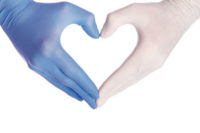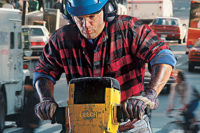This article is intended to help you recognize your workers’ risk factors, symptoms, treatment and prevention of heat-related illnesses.
Is global warming causing more heat-related illnesses in the workforce today or are work-related tasks and personal protective clothing causing more heat-related illnesses? The National Oceanic Atmospheric Administration (NOAA) reported that 206 people died in 2011 compared to 138 in 2010.
The national average is normally around 119 deaths per year.
Although OSHA has done a great job of helping to protect employees by providing personal protective equipment standards, the equipment can sometimes increase the chance of a heat-related illness. OSHA does not have a specific standard that covers workers in hot environments; nonetheless, the OSHA General Duty Clause states that employers have a duty to protect workers from recognized serious hazards in the workplace, which includes heat-related hazards.
The problem
Workers exposed to hot and humid conditions are at risk for heat-related illness. Both heat and humidity are variables of the heat index. The heat index is recognized by OSHA and is a single value that takes both temperature and humidity into account and assigns it a specific number.
Humidity is a measure of the amount of moisture in the air. When the air is moist, sweat does not evaporate off of the body. This can be dangerous as evaporation of sweat is one of the ways our body cools itself. Plus, wind is what helps evaporate the sweat from our bodies and if there is no breeze, the sweat does not evaporate. For this reason, wearing thick, heavy personal protective clothing can hinder the evaporation of sweat and increase heat-related illness as well.
The higher the heat index number, the warmer the weather feels and there is a greater risk for heat-related illness. The important number to remember is 90. If the heat index is below 90, the risk level is low and if it is above 90, the risk level is higher. Also, if the temperature and humidity are both above 90, the NOAA issues an Extreme Danger Alert.
Risk factors
Workers new to outdoor jobs are usually the most at risk for heat-related illnesses. Also, anyone is at a higher risk when hot weather arrives suddenly or early in the season before workers have a chance to adapt or acclimatize to the warm weather. Acclimatization means the worker needs to gradually increase the workload in small intervals and take more frequent breaks. This helps the worker build up a tolerance for hot conditions and usually takes about one week.
Other factors that may cause heat-related illnesses can be personal to each worker such as poor physical condition, obesity, kidney disease, dehydration, pregnancy, alcoholism, hypertension, cardiac problems and previous problems with heat. Risk factors can also be increased by certain medications such as water pills, sedatives, tranquilizers, stimulants and some heart pills. Finally, age can affect the response to high heat conditions. Children less than 4 years old and adults over 65 are more vulnerable to heat stress because they adjust to heat at a slower rate than other people.
Recognizing heat-related illnesses
There are four types of heat-related illnesses that can cause minor irritation or lead to serious complications and even death if not recognized and treated quickly.
1 Heat Rash
Heat rash, also known as prickly heat, appears as clusters of red spots or small bumps on the skin. They often appear on the neck, chest, upper back, arms, or folds of skin where clothing is somewhat restrictive. The rash develops when skin is persistently wet with perspiration and the bumps can become infected.
Treatment for heat rash is to keep the affected area dry and the victim in a cooler, less humid environment that is shaded or air-conditioned.
2 Heat Cramps
Heat cramps are painful muscle spasms in the abdomen, arms or legs. They can occur after vigorous exercise or intense physical activity in hot and humid weather or heavy non-breathable clothing. Muscle cramping is due to a loss of electrolytes such as sodium, which is why our sweat tastes like salt.
Treatment for heat cramps is to rest in a cool area and drink plenty of water mixed with a teaspoon of salt per quart or electrolyte replacement drinks.
3 Heat Exhaustion
Heat exhaustion is a result of excessive heat and dehydration caused by insufficient water and salt intake. A hot and humid environment doesn’t allow the sweat to evaporate off the skin to cool the body down.
Signs and symptoms may include pale, clammy skin (heavy sweat), fatigue, dizziness, nausea, shallow breathing, rapid pulse and intense thirst.
Treatment for heat exhaustion is to cool down quickly by placing the person on their back with their feet slightly elevated in a cool, shaded area with a fan blowing on them or towels to fan them. Fanning the victim will help the sweat evaporate.
It is also recommended to provide cool liquids such as water with a teaspoon of salt per quart or electrolyte replacement drinks. Don’t use salt tablets by themselves, as this will improve their sodium levels but not replace the fluids and may cause further dehydration.
If the victim’s condition does not improve in about 30 minutes or they are unable to drink fluids due to nausea and vomiting, seek medical attention to administer intravenous (IV) fluids.
4 Heat Stroke
Heat stroke is a true emergency and you should seek medical attention immediately. The victim may have some or all of the previous symptoms; however, the important sign to recognize is their altered mental status or unconsciousness. This is caused by a breakdown of the body’s heat-regulating mechanisms or complete dehydration and loss of sweat.
Signs and symptoms include hot, dry, flushed skin; rapid heartbeat; confusion; unconsciousness and seizures. Body temperature could be over 105°F, which the brain cannot handle and causes the altered mental state.
Treatment for heat stroke is to cool the victim rapidly while waiting for medical help. Place the victim in a cool shaded area, remove outer clothing, and spray them with lukewarm water. Lukewarm water evaporates quicker than cold water while fanning them.
You can place cold packs in their armpits, groin, forehead, and behind their neck to cool the core body and brain. You can also place the victim in a cool bath of water as long as shivering doesn’t occur because this can raise their body temperature.
Even though it is important to replace fluids as soon as possible, don’t administer liquids to a victim in an altered mental status since there is a risk of these liquids being aspirated into the lungs. Medical professionals will give cool IV fluids to the victim when they arrive on scene.
Prevention
Heat-related illness prevention is the key to avoiding an emergency. Here is a list of methods to prevent heat stress:
• Schedule hot jobs for the cooler part of the day
• Schedule routine maintenance during the cooler seasons of the year
• Wear loose-fitting clothing
• Drink water often (don’t wait until you’re thirsty)
• Provide additional breaks in comfortable shaded areas
• Add additional personnel to reduce exposure time
• Have hot weather supplies available
• Get workers acclimated slowly to hot days (acclimatization)
• Train workers to recognize symptoms of heat stress
• Check workers heart rate, temperature and mental state often
• Have an Emergency Action Plan ready
Special clothing and equipment to stay cool
• Cooling vests with cold packs on inside pockets
• Cooling vests that are submerged in cold water before use
• Cooling vests that circulate cool water around the body core
• Cooling neck wraps that are submerged in cold water
• Ventilated hard hats with wide brims and shaded neck covers
• Air supplied respirators with cooling valves
• Heat stress monitors
Understanding the signs and symptoms of heat-related illnesses and prevention methods will help keep your employees safe and your workplace running smoothly during the hot summer months.
Sources


